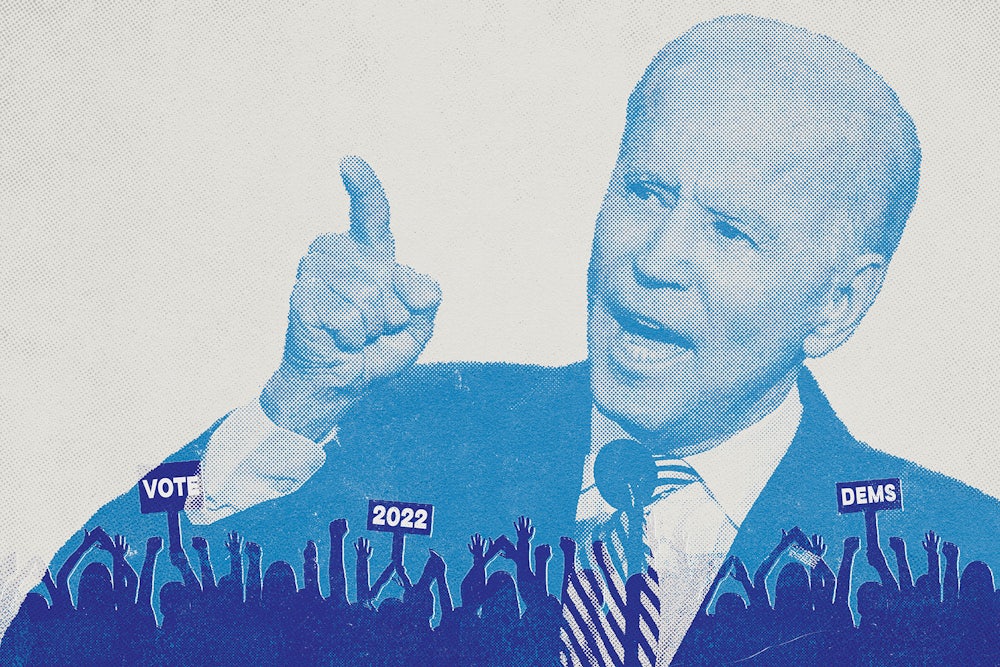In politics, the rule is treated as immutable, like the law of gravity that Isaac Newton supposedly conceived while sitting under an apple tree in 1666. The political equivalent is the dictum that the party that controls the White House is doomed to lose congressional seats in every off-year election. Presidential victories are invariably followed by an outgoing tide that takes away the winning party’s congressional seats.
Like Newton’s laws of physics, this one is based on intense observation of the real world. Since the Civil War, the president’s party has gained off-year House seats only three times. And many of these repudiations of a sitting president have been stunningly unequivocal: Since 1934, the Oval Office party has lost 40 or more House seats in nine off-year elections. The Senate numbers are less dramatic, but still lopsided: The party in power gained seats in just seven of 26 off-year elections since 1913, when the Seventeenth Amendment mandated direct election of senators.
These historical numbers would be daunting for any new president. But because of Democratic down-ballot disappointments in 2020, Joe Biden currently holds the kind of congressional majorities that could be temporarily jeopardized if a small private plane of legislators was grounded by fog at Martha’s Vineyard Airport during fundraising season. In the 50-50 Senate, Kamala Harris is the Democrats’ majority. And in the House, where Democrats hold just a three-seat edge and both the far left and the skittish moderates have veto power, Nancy Pelosi’s legislative genius is demonstrated each time the House passes a complex measure.
At first glance, there seems to be an inherent logic to this off-year pattern, especially for Democratic presidents. In 1992, Bill Clinton won just 43 percent of the vote, and by 1994 may have overreached his shaky mandate. In 2010, Barack Obama suffered because an inadequately sized stimulus failed to solve the problem that afflicted voters: the economic pain from the Great Recession. The successful Republican cry that year was “Where are the jobs?”
Small wonder that Democrats regard the first off-year election of a president’s term with a trepidation not unlike that which Jaws inspires in ocean swimmers. In 1994, after they lost 52 House seats and eight Senate seats, Democrats were unexpectedly confronted with the specter of Speaker Newt Gingrich. In 2010, Obama topped that record by enduring the worst off-year drubbing since 1938: 63 House seats plus six Senate seats.
The result is that the Democrats govern with the frenzied desperation of a sailor on a 24-hour shore leave. The default strategy is to pass as much as humanly possible in the first 18 months of a presidency, because after that, as Clinton and Obama demonstrated, governing will presumably be limited to erasable executive orders and foreign policy. These days, this sense of urgency is fanned by Democratic activists and cause groups. Biden—with the flimsiest congressional majorities since Dwight D. Eisenhower in 1953—is expected to rebuild the nation’s infrastructure, aggressively battle climate change, uphold voting rights, break the logjam on immigration, and, if Stephen Breyer retires, fill a Supreme Court vacancy. And he must do it all well in advance of the 2022 elections.
Adding to Democratic despair is the conviction that gerrymandering and voter suppression have rigged the wheel for the Republicans in 2022. A decade of Democratic setbacks in state legislative races will allow the Republicans to shape House redistricting in such key states as Texas, Florida, North Carolina, Georgia, and Ohio. At least redistricting is a two-way street, and Democrats will have some opportunities at self-interested map-drawing in New York and Illinois. But there is nothing fair about Republican efforts to depress minority turnout by limiting early voting, creating new obstacles for mail-in ballots, and purging the voter rolls.
It all sounds bleak enough to believe that maybe, pretty soon, they will be carving Donald Trump’s head on Mount Rushmore. In this telling, the Democrats will always remember the early days of the Biden presidency as the last moment when far-reaching legislative change was ever possible. An emblematic Farhad Manjoo column in The New York Times was headlined: “DEMOCRATS HAVE A YEAR TO SAVE THE PLANET.” That brief, shining moment will end in November 2022, as the invisible hand of historical inevitability passes control of Congress back to the Republicans for eternity.
Democrats these days make Cassandra from the Trojan War seem like a cockeyed optimist. Intimations of doom appear to be as large a part of the Democratic credo as the belief in health care for everyone and the commitment to diversity. Instead of the donkey as the symbol of the Democratic Party, it might be appropriate to go with a man and a woman holding aloft a placard that declares, THE END IS NIGH.
Enough with the black crepe and ashes. It is time to treat the supposedly dread Off-Year Curse like it is nothing more than the title of a cheesy horror movie. Because a strong case can be made that the Democrats could actually gain House and Senate seats in the 2022 midterm elections. Fourteen months before the congressional elections—with the House district lines not even drawn yet—it is folly to make precise predictions. But the omens do look propitious for the Democrats.
What about those fearsome historical precedents?
Let’s begin by examining those three pesky post–Civil War exceptions to the Iron Law that the party that controls the White House invariably loses midterm House seats. In 1934, in the depths of the Depression, the Democrats under Franklin D. Roosevelt bucked the trend by gaining congressional seats. It is hard to derive a larger moral from that year beyond FDR being wildly popular, and his predecessor Herbert Hoover being reviled.
But a different story emerges when we look at the last seven off-year elections—a period beginning in 1994 that roughly corresponds to the rise of cable TV news and increased political polarization. Two recent exceptions—1998 and 2002—hold major lessons for 2022. (No one, it should be said, would be rushing to notify Guinness World Records if he or she tossed a penny seven times and it landed heads twice.)
In 1998, the Republicans went into full frenzy over Clinton’s lying about his tawdry behavior with a White House intern. Republican strategist David Winston, who was then a top Newt Gingrich adviser, recalls major internal GOP debates over whether to go into the off-year elections with a positive message or whether to just fan the flames of impeachment fever. Winston, who was on the losing side of that strategic argument, points out that in 1998 the Republicans had a political case for themselves based on the record of the GOP-controlled Congress in balancing the budget, reforming welfare, helping lower the unemployment rate, and producing economic growth.
What the Republican zealots failed to understand in 1998 was that the voters possessed the ability to separate Clinton’s job performance from his disturbing personal conduct. A Gallup analysis found that, counterintuitively, Clinton received some of the highest job approval ratings of his presidency during the impeachment saga. The exit polls after the 1998 congressional elections backed this up; 55 percent of the voters approved of Clinton’s handling of the presidency, while only 35 percent had a favorable view of him as a person. Reflecting this realistic view of Clinton’s governing strengths and moral weaknesses, 63 percent of the voters in the exit polls believed that Congress should drop the entire impeachment inquiry.
The 1998 results: The Democrats gained five House seats that year and held their own in the Senate. Winston, who is a longtime adviser to congressional Republicans, grasped the obvious current parallels to 1998. As he put it to me, “If the entire Republican message becomes all about how awful Joe Biden is and how bad the Democrats are, we could have a repeat in 2022.”
The 2002 elections took place in the shadow of the September 11 attacks—an unprecedented event that rocked the nation to its core, and the closest analogue in modern times to the pandemic. George W. Bush and the Republicans that year benefited from reapportionment and the shift of House seats from the East and the industrial Midwest to the Sunbelt. In the South, the Democrats also suffered from realignment, as conservative white voters continued their migration to the Republican Party.
Summarizing the 2002 results in his forthcoming book on the last half-century of House races, The Long Red Thread, election analyst Kyle Kondik writes, “Had Bush been a liability in 2002 instead of an asset, Republicans might have lost the House anyway. But the combination of redistricting and reapportionment protected against a Democratic comeback, and Bush and the national political environment took care of the rest.”
No modern president, certainly including Biden, has ever embodied a rally-round-the-flag effect as Bush did after 9/11. His approval rating hit 90 percent after the Twin Towers toppled in 2001 and stayed above 60 all during the run-up to the 2002 elections. Republicans also displayed no compunction about assailing the patriotism of incumbent Democrats such as Georgia Senator Max Cleland, who had lost both legs and an arm in Vietnam. A scurrilous attack ad by GOP challenger Saxby Chambliss against Cleland featured photographs of Osama bin Laden and Saddam Hussein. This kind of fearmongering worked, because 83 percent of voters in the 2002 national exit polls were at least “somewhat worried” about another terrorist attack. In the end, Bush and the Republicans gained eight House seats and picked up two Senate seats, including Cleland’s.
No prior election provides automatic guideposts to 2022. House elections were more likely to pivot around local factors and incumbency in 1998 and 2002 than they do now. Also, the turn of the twenty-first century was at the tail end of an era defined by ticket-splitting. In 2000, voters in 86 House districts voted one way for president and the other way for Congress. In sharp contrast, that number dwindled in 2020 to just 16 such Janus-faced House districts.
But all the caveats in the world still leave us with lasting lessons from these two elections that defied the Off-Year Curse. In 1998, the Republicans played to the passions for vengeance among their red-meat partisans instead of appealing to swing voters who had more pressing personal concerns than the morality of the incumbent president. And, in 2002, Bush and the Republicans beat the historical precedents in large measure by being perceived at the time as having successfully surmounted a devastating crisis.
Since redistricting has yet to begin and state voting laws are still in flux, no final verdict is possible on GOP efforts to rig the 2022 elections. But the way that Democrats these days reflexively link “gerrymander” with “voter suppression,” it seems as if the words have been mushed into one phrase rather than remaining two distinct problems with differing implications for 2022. On a national basis, gerrymanders, of course, only affect House races, because you can’t redistrict states, as tempting as it might be in the case of Texas. In contrast, voter suppression is more likely to manifest itself in statewide races rather than individual congressional districts. Most Democratic-held seats in the South—where GOP efforts to discourage Blacks from voting are the most insidious—are majority minority districts. It doesn’t really matter whether the Democrats carry John Lewis’s old, mostly Atlanta-based House district with 85 percent of the vote (Nikema Williams’s winning margin in 2020) or 82 percent. But those potentially lost votes might affect Raphael Warnock’s reelection campaign for the Senate.
Because of the pandemic, states still haven’t received the block-by-block Census data, which is the raw material needed for redistricting. In a state like Texas, which gains two House seats in 2022, it will be pivotal to know precisely where in the state the population growth is centered. But in keeping with their the-sky-is-falling mentality, many Democrats assume that double-digit Republican gains from redistricting alone will guarantee a long line of GOP House speakers, probably culminating with Marjorie Taylor Greene. But this ingrained pessimism leaves out the inescapable reality that if you keep gerrymandering the same states, you do not gain new House seats. “There are states that can’t get worse, like Michigan and Ohio,” said Ali Lapp, the founder and president of House Majority PAC, which raised $160 million for the Democrats in the 2020 election cycle. Pointing to New York and Illinois, where the Democrats have a redistricting advantage, she concluded, “I think the national result of all these states will be a wash.”
Kyle Kondik, the managing editor of Sabato’s Crystal Ball, a political handicapping newsletter at the University of Virginia, believes that GOP redistricting gains might go as high as five or six seats. But Kondik stresses that just because the Republicans can rig more districts than that does not mean they actually will. It is not as if the GOP suddenly will become the party of good-government reformers. But Kondik points out the forgotten part of the equation “is what House members want and what state legislators want.”
House members, who often have major backstage roles during redistricting, have motivations beyond trying to maximize the number of seats that their party will win. Most GOP incumbents, for example, would prefer to run in a 64 percent Republican district rather than in a 54 percent district, even if absorbing some additional Democratic turf meant that their party would gain House seats elsewhere in the state. In politics, as in life, self-interest usually trumps everything. And the true goal of most incumbents is to have as relaxed a road to reelection as possible.
A prime example is Mitch McConnell’s home state of Kentucky, where the Republicans control every lever of redistricting. In theory, that means that the GOP could eliminate the lone Democrat in the state’s congressional delegation by splitting Democrat John Yarmuth’s Louisville-based district into three parts. Politico reports that McConnell and most of the Republicans in the congressional delegation are resisting the temptation to erase Yarmuth’s district. Their reasons range from fear of protracted court challenges to the risk that demographic change around Nashville would reshape the political makeup of the new districts by the end of the decade. The Politico article quotes North Carolina GOP Representative Patrick McHenry as saying, “There’s an old saying: Pigs get fat. Hogs are slaughtered. And when it comes to redistricting, that is, in fact, the case.”
Voter suppression brings with it a conundrum: Just because a tactic is reprehensible does not automatically make it effective. Trying to measure the electoral results of Republican legislative efforts to depress minority turnout is the political equivalent of a Labor of Hercules, especially since the pandemic distorted normal turnout patterns in 2020 (46 percent of the electorate voted by mail or absentee). Moreover, Democrats in Washington and liberal think-tank experts resist quantifying voter suppression out of a reluctance to minimize the impact of this coordinated legal assault on democracy.
Some of these efforts to restrict minority turnout could have a boomerang effect. Anecdotal evidence in Georgia and elsewhere in the South suggests that Black voters are willing to endure massive inconvenience and long waits at the polls to ensure that they do not lose their hard-won right to vote. That in no way justifies the Republican assault on voting rights. But it does suggest that these gutter tactics are not nearly as effective as many Democrats fear.
Justin Grimmer, a political scientist at Stanford University who has studied these issues, makes the point that many of the legal changes mandating IDs at the polls, restricting early voting, and toughening the standards for absentee ballots also affect Republicans. The laws on absentee voting, for example, may be aimed solely at Democrats, but they easily could also catch elderly Republicans in the crosshairs. In a democracy, as Grimmer stresses, it is appalling if 1,000 people lose their votes in a statewide race. But, as he put it, “If the breakdown is 60 percent Democrats and 40 percent Republicans, it may not have much of an effect on the outcome.”
Missing in many Democratic laments over gerrymandering and voter suppression is a sense of proportion. By exaggerating the powers of Republicans’ cynical behavior, Democrats risk falling into a slough of despond. A sense of foreboding about 2022 can easily lead to depressed Democratic turnout. Remember that Republicans would not feel forced to resort to desperation tactics like voter suppression if they believed that they were on the right side of history and the coming decade.
The most evocative campaign commercial of the last four decades began with the words, “It’s morning again in America.” Ronald Reagan’s 1984 spot, in the spirit of McDonald’s and Pepsi’s feel-good ads of the era, celebrated an America on the rebound, with men in business suits stepping into taxicabs, paperboys on bicycles roaming suburban neighborhoods, and, of course, a bride and groom at the altar. A soothing male voice-over declared, “This afternoon, 6,500 young men and women will be married. And with inflation at less than half of what it was just four years ago, they can look forward with confidence to the future.”
You wouldn’t know from the ad that the unemployment rate stayed above 7 percent all through 1984, or that, during the start of 1983, Reagan’s own approval rating had gotten as low as 35 percent. In 1984, what mattered for Reagan in his landslide reelection was not the actual numbers, but the trajectory. As a Labor Department report reviewing the year summarized, “The employment situation in 1984 reflected extraordinary rates of employment growth in the first 2 quarters.”
The strongest case that the Democrats could make for themselves in 2022 would be to reprise “Morning in America.” That, of course, assumes that the pace of vaccinations keeps the Delta variant (and other future mutations) at bay—and that Americans continue to revel in the return to mask-less, Zoom-free, and hug-filled lives. Similarly, for this strategy to work for Democrats, the economy needs to keep expanding, with bursts of inflation limited to temporary bottlenecks.
Fourteen months before the 2022 elections is far too early to place too much stock in Biden’s approval ratings (consistently a few ticks above 50 percent). Most pollsters have not even begun asking voters about what party they prefer (the generic ballot question), while any head-to-head Senate matchups are evanescent tests of name recognition. As a result, the best gauges about the national mood can be found in surveys that do not even mention politics.
Since 2008, Gallup has been asking online panels to rate how they feel about their lives (on a 0–10 scale) and how they envision their lives in five years. A June survey found that Americans reported higher life satisfaction now and in the future than in any prior Gallup survey—a sharp jump from a historic low point during the Covid spring of 2020 and a significant improvement over the mixed ratings at time of Biden’s inauguration.
To put it in the simplest possible terms: With Joe Biden in the White House, life is getting better for most Americans, and they anticipate that the good times will continue. As the Gallup write-up of the survey notes, “Beyond the vaccination rollout and improving economic conditions, though, is the critical psychological benefit of renewed social interaction. Reuniting in person with family and friends and joining in large gatherings of people such as at sporting events is a crucial part of social wellbeing.”
(Full Disclosure: I have been part of an online Gallup panel for years. While I cannot recall if my upbeat post-vaccination assessment was part of the June survey, I do know that the question in the past has caused me to seriously ponder in a way that I do not with queries on political preferences and policy issues. Why as a journalist do I participate in such surveys? Much as conscience-stricken hedge funders give back by donating wings to major hospitals and buildings to Ivy League universities, I give back as a political reporter by honestly answering questions from reputable pollsters.)
Many left-wing Democrats believe that the 2022 elections will pivot around a lengthy legislative to-do list on Capitol Hill. This line of thought suggests that unless Biden delivers on epic climate-change legislation, immigration reform, voting rights, and a CVS-receipt–size list of other pet issues, the Democrats will be viewed as failures. But activists with these unrealistic expectations fail to appreciate that Biden has already accomplished far more than most presidents going into the midterm elections. Consider his $1.9 trillion stimulus package, his vaccination rollout, and the dramatic change of tone in Washington. As the Democratic pollster Mark Mellman told me, “People are not going to evaluate Joe Biden on the number of bills that he passed, but on the direction of the country.”
This far in advance, the list of senators and House members who are retiring in 2022 can serve as a rough proxy for each party’s prospects for holding a majority. The assumption is that the frustrations of serving in the minority make the life (and the paycheck) of a lobbyist far more alluring than running for another term with diminished power. That is why it is telling that so far only a handful of House Democrats have announced plans to run for other offices or leave elective politics. In contrast, five Senate Republicans whose seats are on the ballot in 2022 have already announced their retirements, with the future plans of Trump toady Ron Johnson in Wisconsin and 87-year-old Chuck Grassley in Iowa still undetermined.
Unlike 2018, when the Democrats had to defend Senate seats in such flaming red Trump states as North Dakota, West Virginia, Montana, and Missouri, the 2022 map gives the party reason for optimism. This time around, the rough consensus is that the most endangered Democratic incumbent is New Hampshire’s Maggie Hassan, since popular Governor Chris Sununu (a 68 percent approval rating) may well be her formidable Republican challenger. When the Democrats’ toughest state is New Hampshire, which last opted for a GOP presidential candidate in 2000, it is a far cry from even 2020, when the party knew from the outset that Doug Jones was doomed to defeat in Alabama.
In 2022, no Senate Democrat will be on the ballot in a state that Trump carried in the last election. But Raphael Warnock in Georgia and Mark Kelly in Arizona—two states where Biden’s 2020 margins were somewhere between an eyelash and a whisker—are running again after being elected to just partial terms. It is premature to give Daily Racing Form rundowns of key Senate races. But the Democrats are well-positioned to make gains with open GOP-held seats in Pennsylvania and North Carolina, as well as in Wisconsin, whether or not Johnson runs for a third term. Perhaps the biggest Senate advantage the Democrats will have in 2022 is the likelihood of divisive Republican primaries in battleground states. In 2017–2018, the Democrats won six key Senate races (Alabama, Arizona, Michigan, Montana, West Virginia, and Wisconsin) following scorched-earth GOP primaries.
The most enduring joke in politics—a joke that has launched enough memes to sustain Twitter for a century—is that “it all comes down to turnout.” It may be a laugh line, much like Infrastructure Week under Trump, but it is also the biggest unknown about 2022. Nancy Pelosi is speaker for a simple reason: Democratic turnout in 2018 was the highest for an off-year election in more than a century and produced a 40-seat pickup in the House that sustains the party’s narrow majority today.
But will Democrats and Democratic-leaning independents again vote in record numbers in 2022 without Trump in the White House or on the ballot? A strong argument can be made that Tip O’Neill’s dictum has been reversed, and these days “all politics are national,” as ticket-splitting appears to be going the way of the Prohibition Party. True, the Republicans have been adept at locating forgotten pockets of rural white voters. But the Democrats, with a long history of their voters going AWOL in non-presidential years, probably have the most to gain from the fervent attitude that both sides now bring to all elections.
The political scientist and election forecaster Rachel Bitecofer is a strong adherent to the concept of negative partisanship, the idea that voters are primarily motivated by scorn for the other party. For 2022, she is devoting her energies to launching StrikePAC, a political group trying to brand the entire Republican Party as far-right extremists. Her motivation: fear that the Biden White House and most Democratic consultants are too reasonable and too reluctant to go for the jugular. As she said in an interview, “Happy people don’t vote. You know who’s always unhappy? The Republicans.”
Bitecofer believes that the most important measure going into 2022 will be the level of enthusiasm of the Democratic coalition. But a strong case can be made that the makeup of the 2022 Democratic coalition also matters, since higher-income and better-educated voters tend to be the most reliable voters. These days, for better or worse, the Democrats are increasingly the party of high SAT scores. According to the data analysis firm Catalist, the Democrats’ performance among white college-educated voters jumped from 46 percent support in 2012 (when Barack Obama won 51 percent of the vote nationally) to a comfortable 54 percent in 2018 and 2020. The upshot of these demographic changes, Ali Lapp from House Majority PAC argues, is that “the idea that the Democrats are the party of inconsistent voters is no longer true.”
But the Democrats have a secret weapon in 2022: Donald J. Trump.
Unlike any defrocked president since the nineteenth century, Trump seems determined to make the midterms, especially the GOP primaries, into a crusade for his personal vindication. It is as if Herbert Hoover stumped for Republican candidates in 1934—two years after he carried just six states in his reelection bid—by claiming that it was “fake news” that he was paralyzed in the face of the Depression. Imagine if in 1974, just months after he resigned in disgrace, Richard Nixon toured the nation with an “I should have burned the White House tapes” rehabilitation tour. But Trump—whose ego needs were never going to be sated by crashing a wedding at Mar-a-Lago to rant about a stolen election—has embarked on a single-minded mission to quash all dissent within the Republican Party.
Pollster Mark Mellman captured the GOP dilemma: “The problem that the Republicans have is that they think that Donald Trump is the secret for turning out the base. And for Democrats, he’s a red flag in front of a bull.” In 2020, Trump did inspire a hidden battalion of MAGA-hatted voters who had skipped both 2016 and 2018. According to an in-depth Pew Research Center study, which combined poll results with the records of actual voting turnout, 19 percent of 2020 voters had not cast ballots in the prior two elections. That group of occasional voters was evenly split between the two 2020 presidential candidates, although the Biden supporters skewed much younger.
The Republican strategy for creating repeat voters out of this off-and-on cohort is predicated on nonstop fearmongering. Some of the issues that the GOP is flogging are perennials that have worked for Republicans in prior elections—especially crime and immigration. The weaponization of these issues concerns Democratic strategists looking ahead to 2022. But for the Republicans these days, everything is a threat, from door-to-door vaccination drives to elementary school curricula. The GOP seems more obsessed with critical race theory than the John Birch Society during the Cold War ever was with The Communist Manifesto. H.L. Mencken would probably have mocked this kind of Fox News fanaticism as “boob bait.” As a skeptical Republican consultant, who works almost exclusively in swing states, put it, “In the quiet moments before people vote in 2022, I don’t think that they will be thinking about critical race theory.”
Perhaps the Democrats’ biggest hope for 2022 is that Republican primaries for winnable Senate and House seats will be dominated by candidates who might seem extreme even to QAnon believers. Fealty to Trump is not just a popular approach among Republicans—it is a job requirement. Washington Post cartoonist Michael de Adder conjured up a 2021 version of Joseph McCarthy, including the jowls and the five o’clock shadow, badgering a browbeaten GOP witness, “Are you now, or have you ever been, disloyal to Donald Trump?”
Republicans with long memories, starting with Mitch McConnell, know how easy it is to squander a Senate seat if the wrong candidate prevails in a primary. In 2012, Democrat Claire McCaskill won an extra term in the Senate after her Republican opponent, Todd Akin, began talking about the repugnant concept of “legitimate rape.” And in 2010, Christine O’Donnell, the GOP Senate nominee in Delaware who had once bragged about her occult experimentation, was forced to begin her first TV ad by saying earnestly to the camera, “I am not a witch.”
The hardest things for the Democrats to accept 14 months before the 2022 elections are the virtues of patience. If activists allow themselves to take off their dark glasses of gloom and see all the scenarios under which the Democrats could hold Congress in 2022, they might temper their unrealistic expectations about what Biden and the congressional leaders can accomplish in the next year with micrometer majorities on Capitol Hill. In a sense, one of the gravest dangers ahead—both for the Democrats and for American democracy—is the possibility of younger voters giving up on electoral politics because utopia was not achieved in the first two years of the Biden presidency. In truth, as even Isaac Newton might agree, taming a pandemic and reviving a stricken economy is a hell of a ticket to run on.








